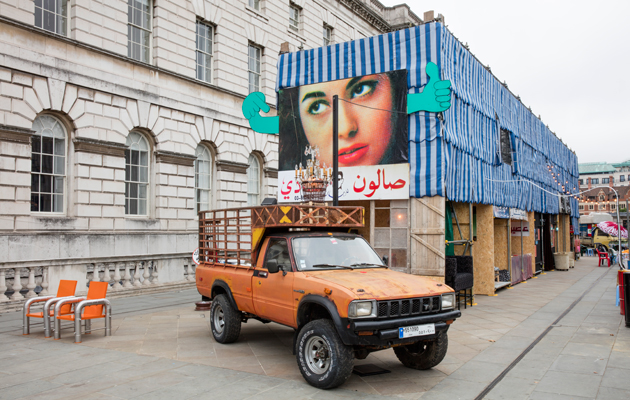|
|
||
|
The designer of the acclaimed Lebanon pavilion at the London Design Biennale tells us how she recreated a Beirut streetscape by the River Thames The first London Design Biennale opened last week at Somerset House, bringing together installations, artworks, designs and prototypes from 37 countries to explore the theme ‘Utopia by Design’. The Lebanese entry attempted to create an authentic experience of the streets of the country’s capital Beirut, through a row of structures that house a small cinema, a barber shop, a room for backgammon, an artisan sewing traditional roll-up mattresses, as well as room for visitors to linger and socialise. Architect Annabel Karim Kassar was awarded the first London Design Biennale Medal for her design. She told us more about the idea behind the installation and the challenges of executing it. ICON Tell me about your idea of utopia and how you’ve manifested it here. Annabel Karim Kassar The thinking stage can be like a wilderness, and I had mental block for three months thinking about the concept, until finally I said, ‘you know what, I have no ideas, I am not going to do this project’. Then suddenly it came to me that my favourite time in Beirut was when I was walking around the streets. I loved to be there and there was something magical about what people were doing in the street, how they interacted with one another. And it clicked with me that this was a kind of design, and created a true sense of utopia in the communities across the city. I go to a lot of exhibitions and I love a lot of what I see, but there are too many re-editions, too much repetition, and it tells me the industry is having difficulties producing new, original design concepts. And, when reflecting on this, I became aware of a great inventiveness about what you find in the streets of Beirut, and people adapt and use objects; I tried to communicate a sense of this here. Health and safety is not an active force in Beirut! It has been a challenge to bring this ingenious and adaptive world to London. For example, the sofas I have placed on top of trucks are directly taken from people I observed casually sitting drinking cola on a sofa resting on top of a truck speeding down the motorway. My versions are just for display! ICON And were you scared? It’s quite ambitious to try and recreate. What was the hardest bit to achieve? AKK I was intimidated by the scale of the project; I couldn’t bring a sense of the street without also bringing its size. So, the logistics were monumental, and the installation brought a huge amount of work in just four days. I organised it like an architectural project, as I would do with a building. Just at a much greater speed! Another challenge was not to make a kitsch copy of Beirut. I wanted to try and interact with the idea of design on the street and not simply replicate it. Some people feel the experience is immersive, but that was not my primary idea. This project is in London and does not try to mask the city around it; glimpses of Somerset House and the Thames are permanently visible and the city’s noises are ever present. We have transposed an aspect of Beirut’s streets onto London and, I hope, created a space for reflection on ways of living. ICON And is your hope that it will become a kind of meeting place? AKK Yes that’s what I had hoped. I am very happy to see people drawn here just to relax and talk to other people; you see Londoners behaving just as Beirutis do. I lived in Lebanon for a long time and I can tell you the important moments in life happen on the streets: you talk and interact with the people around you on the street, you eat on the street, you play on the street, artisans work and trade on the street – everything is there. The doors are always open, and neighbours are like family. The arrangement of the street is a big part of that. ICON You can see a lot of improvisation in the objects around the installation. AKK We were experimenting a lot. There are many conveniently placed coffee tables, which we made from plastic stools with a piece of MDF on top, covered with decorative paper and plastic. It feels very authentic to me; people are always making things rapidly and coming up with new objects. And there is adaptable seating all over the exhibition, people are forming their own arrangements as groups come and go. For example we have used many traditional roll-up mattress; you can walk on them, sit on them, sleep on them. They are very durable – some of them I have had for over ten years. You can make an impromptu sofa with two chairs and a couple of mattresses; it’s immediate and very comfortable. And so you can keep adapting your space to the people around you, whatever you have to use; it is true hospitality and we see it a lot in Beirut. Visit the Lebanon pavilion at the London Design Biennale at Somerset house until 27 September |
Words James McLachlan
Image: Ed Reeve |
|
|
||




















